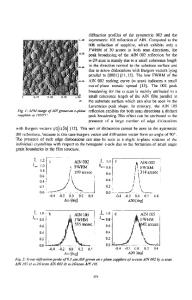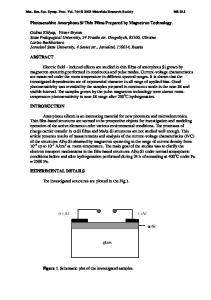Tungsten nitride thin films prepared by MOCVD
- PDF / 886,798 Bytes
- 8 Pages / 576 x 792 pts Page_size
- 116 Downloads / 380 Views
Polycrystalline tungsten nitride thin films were grown by low pressure metallo-organic chemical vapor deposition (MOCVD) using (tBuN)2W(NHtBu)2 as the single-source precursor. Deposition of uniform thin films on glass and silicon substrates was carried out at temperatures 723-923 K in a cold-wall reactor, while the precursor was vaporized at 333-363 K. The growth rates were 2-10 nm/min depending on the condition employed. Bulk elemental composition of the thin films, studied by wavelength dispersive spectroscopy (WDS), is best described as WN, (x = 0.7-1.8). The N/W ratio decreased with increasing temperature of deposition. X-ray diffraction (XRD) studies showed that the films have cubic structures with the lattice parameter a — 0.414-0.418 nm. The lattice parameter decreased with decreasing N/W ratio. Stoichiometric WN thin films showed an average lattice parameter a of 0.4154 nm. X-ray photoelectron spectroscopy (XPS) showed that binding energies of the W4/7/2, W 4/ 5/ 2 , and N l s electrons were 33.0, 35.0, and 397.3 eV, respectively. Elemental distribution within the films, studied by secondary ion mass spectroscopy (SIMS) and Auger spectroscopy depth profilings, was uniform. The SIMS depth profiling also indicated that C and O concentrations were low in the film. Volatile products trapped at 77 K were analyzed by gas chromatography-mass spectroscopy (GC-MS) and nuclear magnetic resonance (NMR). Isobutylene, acetonitrile, hydrogen cyanide, and ammonia were detected in the condensable mixtures. Possible reaction pathways were proposed to speculate the origin of these molecules.
I. INTRODUCTION
x
Tungsten nitride is a potentially useful material for diffusion barriers and gate electrodes in many modern electronic devices.1"5 Traditionally, tungsten nitride is prepared using techniques that employ energized particles, i.e., ion implantation, sputtering, ion-beam-assisted deposition, plasma jet spray, and plasma enhanced chemical vapor deposition.3"7 Alternatively, chemical nitridation of tungsten metal and reduction of WC16, WF 6 , and WO 3 by NH 3 at high temperatures are employed.8"11 Unlike many other transition metal nitrides, thin films of tungsten nitride are rarely grown by chemical vapor deposition (CVD).10-11 We and others showed that organoimido complexes of transition metals can be employed as single-source precursors to grow metal nitride thin films by metallo-organic chemical vapor deposition (MOCVD). 1213 Here, we report the first example of growing tungsten nitride thin films by low pressure MOCVD employing ( t BuN) 2 W(NH t Bu) 2 , 1, an organoimido complex of tungsten, as the single-source precursor.14 J. Mater. Res., Vol. 8, No. 6, Jun 1993
/ NH t Bu
A 'BuN
NH'Bu
II. EXPERIMENTAL The precursor, ( t BuN) 2 W(NH t Bu) 2 , was prepared according to a published procedure and stored in a dry and oxygen-free environment before further use.15 A mixture of deuterium-labeled precursors, ('BuN)2W(NH'Buh-^ND'Bu);, (x = 0-2), was prepared employing l BuNH 2 - x D x (x = 0-2) in the synthesis. The rat
Data Loading...











